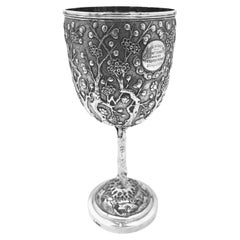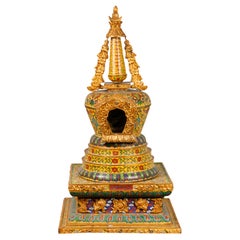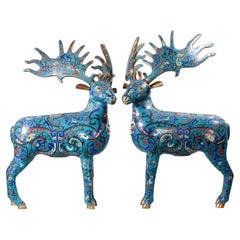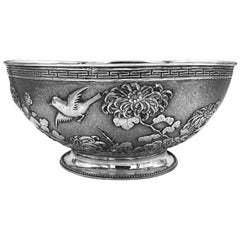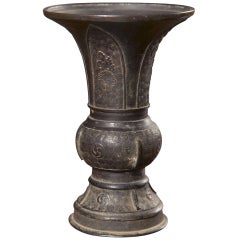Chinese Metalwork
to
63
305
107
458
1
1
2
1
1
1
1
1
1
43
165
250
2
143
50
24
13
10
3
2
2
8
2
1
1
454
140
99
97
75
1,543
1,135
632
460
186
460
459
460
15
5
4
3
3
Place of Origin: Chinese
Chinese Export Silver Goblet
By Luen Wo
Located in London, GB
A Chinese export silver goblet with prunus decoration on a matte background, and the base and stem formed as prunus tree branch root. The body has a single round cartouche engraved "...
Category
Late 19th Century Chinese Export Antique Chinese Metalwork
Materials
Silver
Chinese cloisonné shrine/stupa
Located in New York, NY
decorated in relief; floral motif on yellow ground
Category
Late 20th Century Chinese Metalwork
Materials
Metal
Chinese Silver Card Holder Artist Lee Ching
By Leeching
Located in Buenos Aires, Argentina
Leeching Chinese silver card holder.
Solid silver card holder.
Origin China (Canton) Circa 1840 1870.
Signed on its base (stamp).
Canton manners...
Category
1850s Chinese Export Antique Chinese Metalwork
Materials
Silver
$1,200 Sale Price
20% Off
Pair of Chinese Cloisonné Deer
Located in New York, NY
decorated with stylized scrolls on blue ground
Category
Mid-20th Century Chinese Metalwork
Materials
Metal, Enamel
$12,000 / set
Chinese Export Silver Bowl
By Luen Hing
Located in London, GB
A lovely Chinese silver bowl, embossed and chased with three birds and chrysanthemum against a textured matte background. Made by the firm of Shao Ji'绍记’, and retailed by Luen Hing '...
Category
Late 19th Century Chinese Export Antique Chinese Metalwork
Materials
Silver
Chinese Gu Vase
Located in Stamford, CT
A bronze Chinese Gu vase.
Category
18th Century and Earlier Antique Chinese Metalwork
Materials
Bronze
$2,800
Antique Chinese Silver Gilt, Agate & Enamel Censer
Located in New York, NY
Chinese silver censer, circa 1910. Drum-form agate body set in silver gilt mounts with scrollwork and lunettes. Leaf-capped side bracket handles. Upward tapering support and stepped ...
Category
Early 20th Century Qing Chinese Metalwork
Materials
Agate, Silver, Enamel
Set of Chinese Export Silver Overlay Bottle with Five Cordials Tianjin Wuhua
Located in Atlanta, GA
A set of Chinese Export silver drinking set consists of a pinch bottle and five cordials circa 1910s-1920s. Featuring matching elaborate chased relief dra...
Category
Early 20th Century Chinese Export Chinese Metalwork
Materials
Sterling Silver
Chinese cloisonné square-shaped vase
Located in New York, NY
archaistic motif on blue ground
Category
Late 20th Century Chinese Metalwork
Materials
Metal
Chinese Arcaistic Style Cast Bronze Lidded Urn with Carved Jade Finial
Located in Hudson, NY
This very finely cast bronze urn in an archaistic form was made in the very late 19th century approximately 1895-1900. Done with an apocryphal feeling to honor the ancient past, the vase is beautifully rendered in low relief in bronze covering almost the entire body of the urn. The predominant features are the divided taotie masks that compose the swelling middle body of the vase and also at the corners of the upper section. Crisp but subtle, the casting is clearly handled with great attention to linear form. The patina is very nice and consists of a modeled golden brown with a slight but very lite Verdigris color. The urn has an old rosewood base and lid that seems to have been purpose made for the object. Finally, the whole is set off with a carved jade finial...
Category
Early 20th Century Archaistic Chinese Metalwork
Materials
Jade, Bronze
Pair of Chinese Export Silver Tankards
Located in London, GB
A rare pair of Chinese export silver mugs/tankards, each with figural Court scenes, bamboo, and dragon handles. They have the mark for Hoaching of Canton, circa 1860, and the Chinese...
Category
Mid-19th Century Chinese Export Antique Chinese Metalwork
Materials
Sterling Silver
$13,626 / set
Early and Fine Chinese Iron Water Bath
Located in Bloomfield Hills, MI
Early 19th to mid 19th century Chinese, Iron, water bath.
With the patina of decades, this cast-iron sarcophagus-shaped bath has its original handles and exudes a timeless floral dec...
Category
1820s Qing Antique Chinese Metalwork
Materials
Iron
Chinese Export Silver Mug
By Yatshing
Located in London, GB
An interesting and delightful Chinese export silver mug, of double-skin construction and decorated with bamboo leaves against a matte backgro...
Category
1840s Chinese Export Antique Chinese Metalwork
Materials
Silver
Chinese Export Silver Biscuit Box
By Wang Hing & Co.
Located in London, GB
A Chinese Export Silver Biscuit Box, round with a collet foot and profusely decorated with applied prunus. against a smooth plain background. The box has...
Category
Late 19th Century Chinese Export Antique Chinese Metalwork
Materials
Silver
Chinese 18th Century Bronze Vase
Located in Hudson, NY
Chinese 18th century bronze vase with mottled patina. Evidence of a small, old repair.
Category
18th Century Antique Chinese Metalwork
Materials
Bronze
Pair of Chinese Export Silver Vases
Located in London, GB
Pair of Chinese silver vases with all-over bamboo decoration and each with a wavy-edge flared rim. They were made by 涂茂兴, TuMaoXing, a retailer in JiuJiang (九江), next to the Yangtze ...
Category
1890s Chinese Export Antique Chinese Metalwork
Materials
Silver
$2,725 / set
Chinese Ormolu and Cloisonné Enamel Vase for the Islamic Market
Located in London, GB
Chinese Ormolu and Cloisonné enamel vase for the Islamic Market.
Chinese, early 20th century
Dimensions: Height 18cm, diameter 26cm
Crafted in Chin...
Category
Early 20th Century Chinese Export Chinese Metalwork
Materials
Bronze, Enamel, Ormolu
Pair of Chinese Export Silver Candlesticks
Located in London, GB
Pair of Chinese Export silver candlesticks with the character for "Luck" on one and "Longevity" on the other. They are attached to round wood stands.
Marked with SW, for Shing Wo, “...
Category
1890s Chinese Export Antique Chinese Metalwork
Materials
Silver
$5,110 / set
Chinese Export Silver Mug with Bamboo Decoration
Located in London, GB
A Chinese Export silver mug with a bamboo handle, and decorated with a bird and moth amongst profuse bamboo decoration on a matte background. T...
Category
1860s Chinese Export Antique Chinese Metalwork
Materials
Silver
Pair of Chinese Export Silver Vases
By Wang Hing & Co.
Located in London, GB
A Pair of Chinese Export Silver Flower Vases of trumpet form, each with circular base and rising to a flared, shaped top. The vases, which are decorated with applied prunus, were ret...
Category
Late 19th Century Chinese Export Antique Chinese Metalwork
Materials
Silver
$3,406 / set
Pair of Chinese Export Silver Candlesticks
By Tuck Chang & Co.
Located in London, GB
A pair of Chinese Export silver candlesticks, marked with TC, for Tuck Chang, 德祥 公记(DeXiangGongJi), a Shanghai retailer from 1901-1934, and with the maker's mark of 培记 (PeiJi).
230gm...
Category
Late 19th Century Chinese Export Antique Chinese Metalwork
Materials
Silver
$2,997 / set
Antique Chinese Ormolu and Cloisonné Enamel Vase for the Islamic Market
Located in London, GB
Antique Chinese ormolu and cloisonné enamel vase for the Islamic Market
Chinese, early 20th century
Dimensions: Height 10cm...
Category
Early 20th Century Chinese Export Chinese Metalwork
Materials
Bronze, Enamel, Ormolu
Two Chinese Export Silver Vases
By Wang Hing & Co.
Located in London, GB
Two Chinese silver vases of cornucopia form, both decorated with applied bamboo and chrysanthemum and on a circular base. The vases are similar yet were made by different silversmith...
Category
Late 19th Century Chinese Export Antique Chinese Metalwork
Materials
Sterling Silver
$3,406 / set
Chinese Export Silver Beaker, circ 1890's
By Wang Hing & Co.
Located in Sarasota, FL
Chinese export repousse beaker, circ 1890. Wieght 3.3 oz., 4 3/8" tall
Category
Late 20th Century Chinese Export Chinese Metalwork
Materials
Silver
19th century Chinese bronze cencer with Buddhist lion decoration circa 1860
Located in Central England, GB
This large Chinese bronze censer dates to circa 1860. It is made in three parts, stand, vessel, and lid. The lid has pierced decorative panels with pine trees and a bold Buddhist lion finial for lifting.
The censer has lifting handles in the shape of bamboo to each side and again also has panels with pine forests with mythical beasts and side mounts in the form of Buddhist lion mastheads.
It is raised on four shaped legs with a beast mask head at the top and sits on the raised and pierced stand.
The decoration on this piece is all hand finished with chasing and engraving giving good detail.
The censer has a green/brown patina. Circa 1860
Censers are a type of vessel for burning incense. In many cultures burning incense has spiritual and religious connotations which influence the design and decoration of the censer.
The lion is one of Buddhism’s most potent symbols. Traditionally the lion is associated with regality, strength and power. It is therefore an appropriate symbol of Buddha who, tradition has it, was a regal prince. As Buddhist priests and monks from India, they brought with them stories of stone Asiatic lions...
Category
Mid-19th Century Chinese Export Antique Chinese Metalwork
Materials
Bronze
Chinese Export Silver Bowl
Located in London, GB
Chinese export silver bowl on plain round pedestal base. The decoration is of two applied opposing dragons against a plain background. The bow...
Category
19th Century Antique Chinese Metalwork
Materials
Silver
$16,352
Chinese Bowl Adorned with Cloisonné Enamel and Arabic Inscriptions
Located in London, GB
Chinese bowl adorned with cloisonné enamel and Arabic inscriptions
Chinese, early 20th century
Measures: Height 20cm, diameter 23cm
This beauti...
Category
Early 20th Century Chinese Metalwork
Materials
Ormolu, Bronze, Enamel
Large Chinese Cloisonné Enamel on brass Dish 19th Century
Located in Bilzen, BE
A large Chinese cloisonné dish with dragon decoration from the 19th century
Good condition, no chips or loose enamel parts
Diameter 36.5 cm
Cloisonné is an ancient technique for dec...
Category
19th Century Qing Antique Chinese Metalwork
Materials
Brass, Enamel
Large Japanese Bronze Relief Enameled Vase, Early 20th Century
Located in Islamabad, PK
Large Japanese, Bronze Relief Enameled Vase, Early 20th Century
The vase's surface is adorned with intricate relief work that depicts a stunning tableau of flowers and birds. The re...
Category
19th Century Qing Antique Chinese Metalwork
Materials
Bronze
Chinese Floral Cloisonné Enamel and Ormolu Vase for Islamic Market
Located in London, GB
Chinese floral Cloisonné enamel and ormolu vase for Islamic Market.
Chinese, early 20th century
Dimensions: Height 20cm, diameter 23cm
This beaut...
Category
Early 20th Century Chinese Export Chinese Metalwork
Materials
Bronze, Enamel, Ormolu
Chinese Blacksmith Iron Scissors on Mount, c. 1850
Located in Chicago, IL
This hand-forged metal sculpture, with its delicate appearance and whimsical shape, was once an integral tool to a 19th century Chinese cobbler’s trade. Made of iron, these scissors ...
Category
Mid-19th Century Qing Antique Chinese Metalwork
Materials
Iron
Chinese Silver Repousse and Cast Goblet by Wang Hing.
By Wang Hing & Co.
Located in Sarasota, FL
Chinese silver repousse goblet by Wang Hing. Depicts Chinese garden scenes. Drgon base with emanating fire. Marked WH for Wang HIng maker and 90 Chinese silver. Weight 7.4 oz
Category
1890s Antique Chinese Metalwork
Materials
Silver
Chinese Floral Islamic Style Cloisonné Enamel and Ormolu Vase
Located in London, GB
Chinese floral Islamic style cloisonné enamel and ormolu vase
Chinese, early 20th century
Dimensions: Height 13cm, diameter 13cm
This beautiful bowl...
Category
Early 20th Century Chinese Export Chinese Metalwork
Materials
Bronze, Enamel, Ormolu
Vintage Chinese Floral Cast Iron Mortar
Located in Chicago, IL
This vintage cast iron mortar from China's Shanxi province is patterned in low relief with a simple floral design. Originally used in a traditional ap...
Category
Mid-20th Century Rustic Chinese Metalwork
Materials
Iron
16th Century Chinese Standing Bronze Figure of a Nobleman
Located in Hudson, NY
Hongzhi Period (1487 - 1505) sculpture of an important man, possibly Confucius. Comes with box.
Category
16th Century Antique Chinese Metalwork
Materials
Bronze
Chinese Ormolu and Cloisonné Enamel Vase for the Islamic Market
Located in London, GB
Chinese Ormolu and Cloisonné enamel vase for the Islamic Market
Chinese, early 20th century
Dimensions: Height 19cm, diameter 23cm
Crafted in China...
Category
Early 20th Century Chinese Export Chinese Metalwork
Materials
Bronze, Enamel, Ormolu
Chinese Export Silver Openwork Dragon Bowl by Wang Hing & Co, Hong Kong, 1890
By Wang Hing & Co.
Located in Sarasota, FL
Chinese silver repousse and openwork bowl, decorated with dragons and flaming pearl. The bowl is marked on the bottom with a Chinese character, "90" for silver purity, and "WH" for W...
Category
Late 19th Century Chinese Export Antique Chinese Metalwork
Materials
Silver
Wave Bench in Mirror Finish Stainless Steel by Zhoujie Zhang
By Zhang Zhoujie
Located in Beverly Hills, CA
The wave bench designed by Zhoujie Zhang continues to implement his design philosophy of spontaneity. By applying the laws of its own gravity, the bench naturally faces downward and ...
Category
21st Century and Contemporary Chinese Metalwork
Materials
Stainless Steel
Pair of Chinese Wine Pitchers
Located in Dallas, TX
Pair of Bronze Chinese Wine Pitchers, with Leopard Handles
Category
18th Century and Earlier Antique Chinese Metalwork
Materials
Bronze
A Monumental Gilt-Lacquered Bronze Ornamental Buddha Sculpture of Vajravidarana
Located in Queens, NY
A Monumental Gilt-Lacquered Bronze Ornamental Buddha Sculpture of Vajravidarana:
A Masterpiece of Sino-Tibetan Craftsmanship, Late 19th Century, Qing Dynasty
This monumental gilt-lacquered bronze ornamental sculpture of Vajravidarana is an extraordinary and commanding piece of art, showcasing the pinnacle of Sino-Tibetan craftsmanship from the late 19th century. The figure of Vajravidarana, a powerful purification deity in Tibetan Buddhism, is meticulously sculpted to embody both spiritual authority and artistic excellence.
Vajravidarana is primarily known for his role in removing spiritual impurities and negativities. Unlike other deities associated with wisdom or compassion, Vajravidarana’s function is centered on purification and healing. He is typically depicted holding a vajra and a bell, symbolizing the cutting away of delusions and the resonance of divine truth. In this striking sculpture, Vajravidarana is shown holding a vishva vajra (the double vajra), a unique and powerful variation of the traditional iconography, which signifies ultimate protection and the dispelling of negative karma.
Vajravidarana: The Supreme Purifier and Protector
Vajravidarana is revered in Tibetan Buddhism as the deity of spiritual purification, called upon to cleanse practitioners of defilements and negative influences. His vajra represents the indestructibility of truth, while his bell signifies the wisdom that resonates through purification rituals. In this sculpture, the presence of the vishva vajra, or double vajra, enhances his association with supreme protection, ensuring the destruction of all spiritual obstacles and afflictions.
The figure’s powerful yet composed expression conveys a sense of unwavering resolve and divine authority. His posture, along with the carefully sculpted details of his robes and ornaments, highlights his function as a guardian against impurity. The inclusion of the vishva vajra rather than the usual single vajra reinforces his role as a supreme protector, capable of dispelling all forms of negativity and restoring balance.
Symbolism of the Mantras and Aureole:
Unlike deities that embody wisdom through duality, Vajravidarana’s iconography is centered on purification and exorcism. The aureole surrounding him is inscribed with sacred purification mantras rather than depictions of a consort. These mantras emphasize his function as a remover of obstacles and impurities, reinforcing his role in Buddhist healing rituals.
The presence of the sacred inscriptions elevates the sculpture’s spiritual significance, making it a focal point for meditation and ritual purification. Practitioners often visualize Vajravidarana radiating purifying light, dissolving afflictions and negative karma. This theme is mirrored in the sculptural repetition of the purification symbols on the aureole, reinforcing the deity’s role as a divine cleanser.
Gilt-Lacquered Bronze: The Artistry of Sino-Tibetan Metalwork:
The craftsmanship of this monumental figure reflects the expertise of late 19th-century Sino-Tibetan metalwork, where traditional Tibetan themes were infused with Chinese artistic sensibilities. Cast in bronze and finished with a rich gilt lacquer, the statue has an otherworldly glow, giving it an ethereal, almost divine presence. The gilding process—applied with exceptional skill—gives the sculpture a striking luminosity that enhances the fine details of the facial features, flowing robes, jewelry, and other elements of the deity’s attire.
The technique employed to create this figure speaks to the high level of craftsmanship that flourished during the late Qing Dynasty and early modern Tibetan art. The ornate details of the robes and the fine texture of the sculpture highlight the exceptional skill of the artisans who brought this work to life. The use of gold and lacquer not only reflects the preciousness of the sculpture but also its spiritual significance as an object meant to inspire reverence and meditation.
An Ornamental Sculpture of Monumental Scale:
Unlike smaller devotional objects, this sculpture is designed as an ornamental masterpiece, intended to make a grand visual and spiritual statement. Its monumental size allows it to dominate any space, offering a commanding presence that is both physically and symbolically impressive. In Buddhist practice, large sculptures of this nature are often placed in temples or meditation halls, where their imposing size and serene presence would encourage contemplation and devotion.
The grand scale of the statue further amplifies the spiritual power it is meant to convey. As a representation of Vajravidarana, it is not only a physical object of beauty but also a conduit for meditation, purification, and enlightenment. The scale of the sculpture also emphasizes the divine stature of the deity, highlighting his importance in the Buddhist tradition as the ultimate force for spiritual cleansing and protection.
Provenance:
Acquired in China in circa 1900
1905 Private Buddhist Temple, Northeast, USA
Private Sale
Solomon Treasure...
Category
Late 19th Century Tibetan Antique Chinese Metalwork
Materials
Bronze
Recently Viewed
View AllMore Ways To Browse
Totai Shippo
Chinese Brass Incense Burner
Copper Persian Tray
Indian Brass Charger
Turkish Copper Pot
Brass Dallah
Burmese Bell
China Brazier
Foo Censer
Japanese Meiji Period Solid Silver
Meiji Bronze Eagle
Ming Chinese Cloisonne
Qajar Engraved
Shakudo Vase
Arabic Coffee Pot
Chinese Cloisonne Incense Burner
Elephant Incense Burner
Islamic Incense
